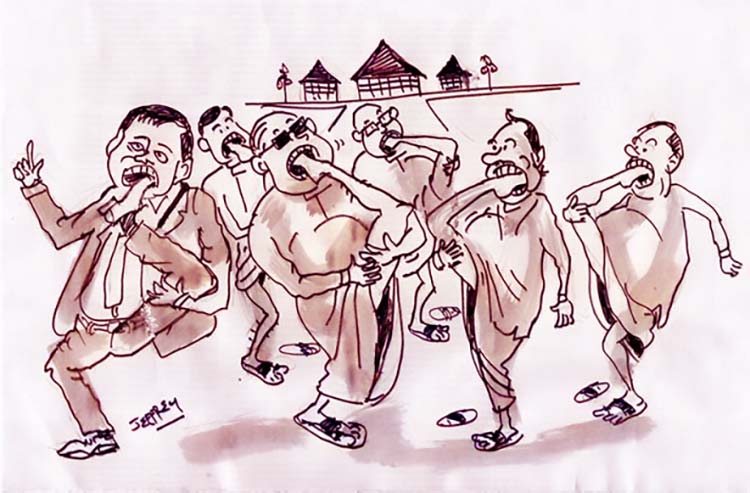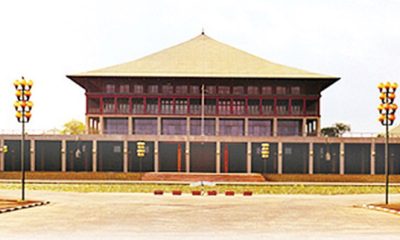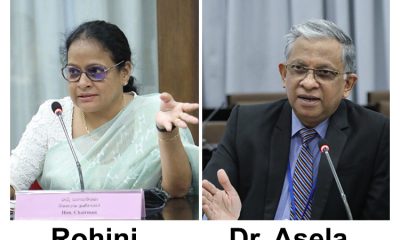Opinion
Redoubtable ‘wisdom’ of our lawmakers

In a move of unadulterated foolhardiness, the powers-that-be published a gazette notification recently to revise Sections 363 and 364 of the Sri Lankan Penal Code. It attempted to lower the girls’ age of consent for sexual intercourse to 14 years and the punishment to be levied to the accused male who has engaged in such sexual activity to be considerably reduced if the accused male is under 22 years of age.
This initiative on the part of the government, set in motion a flurry of heavy and resounding protests by the general public, women’s organisations, and medical professional institutions, against this contemptible attempt to amend the Penal Code by publishing the gazette notification. All these protesting groups have made it very clear that this move is a very retrograde step and does not stand up to any kind of reason or wisdom. Confronted by an avalanche of such drastic objections and protests, the government has given in and withdrawn the said offensive piece of legislation. However, there was a vague suggestion that the ministry concerned would initiate discussions with all the stakeholders on this matter.
It must be pointed out that there is no universally recognised international upper cut-off age limit when a person stops being considered a child. The definition of a child varies across different contexts, cultures, and legal systems right around the globe.
However, the United Nations Convention on the Rights of the Child (UNCRC) defines a child as “every human being below the age of eighteen years, unless under the law applicable to the child, majority is attained earlier.” This convention has been ratified by a vast number of countries, including Sri Lanka, and the age of 18 is widely accepted internationally as the cut-off age for childhood. As just one example, all the banks in Sri Lanka consider anyone under the age of 18 years as a minor and one can get a driving license in our country only when one has reached that magic age of 18. That said, some countries may have different legal definitions and ages for transitions from being a child to being considered an adult. These ages typically range from 16 to 21 in several different jurisdictions.
The minimum age of consent for sexual intercourse is the age at which someone is considered capable of making that decision. The unbiassed objective of the imposition of a minimum age of sexual consent is to protect adolescents from sexual abuse as well as the potential consequences of early sexual activity on their rights and development. Many medical professionals and their organisations have seriously objected to the proposed amendment of the age of consent for sex to be reduced to 14 years from the current age of 16 years, for quite a few compelling medical reasons.
It has been clearly shown by scientific studies that a child of 14 years is not intellectually mature enough by any stretch of imagination to give informed consent for an act such as sexual intercourse. This is simply because she does not have the necessary and adequate understanding of the given situation. To make matters even worse, in this land of Sri Lanka, where acceptable sex education is not provided, a child of 14 years who consents to sexual intercourse is not intellectually empowered and is most likely to be significantly ignorant of the possible repercussions of the sexual act, such as unwanted pregnancy, as well as the potential exposure to sexually transmitted diseases. In other words, that so-called consent is not one which anyone would call fully informed consent.
A child of 14 years is not physically and mentally mature enough to be a mother to a baby she may give birth to, following the sexual act. In addition, such adolescent mothers are a medically high-risk group to develop various complications of pregnancy. These include medical disorders of physical as well as mental nature. The offspring too would be at risk due to inadequate nurturing, as well as to have a propensity to develop physical, intellectual, and emotional problems, well into the future.
It has to be considered that in the proposed amendment, the male culprit’s age is mentioned as under 22 years to qualify for a more lenient judicial sentence. The attempt is to increase it to 22 years from the current limit of 18 years.
Is it the contention of the government that giving in to carnal desires against the law would warrant leniency simply because of an age-related Romeo and Juliet phenomenon? If this is allowed to sail through, there is no guarantee that the upper age cut-off for the male culprit will not be increased further in the future. A wag remarked that even an octogenarian might qualify for a more lenient sentence in the future. All these contentions make one begin to wonder whether there is some ulterior motive behind this.
It is quite interesting to note some of the antecedent events or even the woeful lack of them, before the gazette was published.
We need to carefully assess the policy-making processes, if any for that matter, that were followed before the decision was made to amend the relevant sections of the Penal Code.
It is vital to unravel the processes followed before the authorities jumped in at the deep end to introduce such an offensive bill. One wonders which ministry initiated the process in the first place and wanted the amendments in question effected to the law. We have to examine the exact processes that took place. What was the specific trail that was followed?
Generally speaking, new laws are formulated by relevant ministries, extensively discussed, then sent to the Attorney General, followed by the submission of it to the Legal Draughtsman and finally presented to the Cabinet of Ministers. It is quite clear that none of these formalities were adhered to, as many of these institutions, including the Parliament, have denied any knowledge of this bill that was hastily sprung through a Government Gazette notification.
It is necessary to look for the reasons that prompted this despicable attempt. More than anything, such a detailed analysis would help to guard against and even prevent recurrences of this kind of tyrannical behaviour on the part of the powers-that-be in the future. It has been claimed that the motive behind this is to ensure some legal requirements but one would argue that drastic changes such as the attempted amendments to the Penal Code should only be presented following open and frank discussions with all stakeholders. It is quite obvious that this was not done.
As indicated by a statement in the Parliament on 01 April, 2024, the proposal to amend the relevant sections of the Penal Code have been “withdrawn”. Yet for all this, the Ministry of Justice is now planning to have a so-called dialogue with interested parties in the immediate future regarding these proposed amendments to the Sri Lankan Penal Code.
The implications are that the so-called bill has not been withdrawn once and for all; at least not as yet.
To make matters worse, it is likely to be presented again and rushed through the parliament. There have been many instances where the authorities withdrew some controversial legislations following intense protests only to present them again a slightly modified form and pushed through the legislature. So, watch out people …, we need to remain intensely vigilant.
Concerned Sri Lankan
Opinion
Dhammam Saranam

It may hurt our pride, but we must admit that our Buddhist education has failed. It adheres to the tradition of memorizing, especially post canonical poetry and commentaries while discouraging critical thinking. The current sorry state of social institutions is living evidence of that failure. Solutions to chronic problems of this nature will take time to bear results, but there is no better time to act than now. We must teach the future generations, using terms they understand, that Dhamma is a way to see the reality of nature and our place in it, and knowing it with wisdom will allow us to live a happy and successful life here and now. We must stress the fact, and be proud of it, that Dhamma is not only compatible with science, but it is also ahead of our times, a unique feature. Future generations of Sangha must be trained to critically evaluate the utility of prevailing practices that Buddha had rejected. Understanding Dhamma does not have to wait for the arrival of a Buddha who is not even mentioned in the Pali Canon. Let us teach future generations, in their language, that Dhammam Saranam means is to ‘Face life armed with the wisdom of Dhamma, free of baseless beliefs and futile rituals.’
(The first part of this article appeared yesterday)
A third characteristic derived from this first principle has to do with human knowledge, or the way they know about their world. Dhamma describes the cognitive process, or the way humans become aware of their world, using the formula referred to as the Five Aggregates (Pancakkhanda). Dhamma ascribes knowledge to what is acquired through the sense organs consisting of eye, ear, nose, tongue, and the body, and deliberations by mind, which is the sixth sense faculty. The stimuli received by the sense organs (Vedana) are received by the brain in the form of electrochemical signals (Sanna), where that data is interpreted and assembled into mental formations (Sankhara).
The brain is isolated from the outside world and relies solely on the information sent by the sense organs to construct an image of the object or phenomenon that caused the stimulus. There is a major shortcoming in this process. That is, there is no way humans can know how accurately the mind interprets the information in constructing mental images. Humans think they see, hear, taste, smell and feel things, but they only become aware of things. Awareness and reality are not the same, and we have no way of knowing how close the former represents the latter. Furthermore, the sense organs, brain, and its activities, as well as all phenomena the sense organs encounter are in flux. Human sense organs have not evolved to see reality, yet we become aware of our world through this process and get attached to them. Dhamma describes this process, the Five Aggregates, as the human condition, or Dukkha in Pali (Sankittena pancupadanakkhanda dukkha).
These limitations of the human cognitive system that the Buddha described two and half millennia ago, have been confirmed by modern science. Dhamma describes this as a state of ignorance (Avijja). That means humans have no way of knowing how closely the mental construct of their world represents reality. This is a subject of quantum physics as well. Einstein described this condition as an illusion, and he said that the purpose of any religion should be to help humans overcome this condition. That is exactly what Dhamma is about: it considers life, the condition in which humans must deal with things that are in flux and beyond control, while not knowing reality is unsatisfactory. It describes this condition as Dukkha. That does not mean life is misery; there is nothing good or bad about life, life is what it is.
Dhamma does not stop there, it also explains the arising (Samudaya), cessation (Nirodha), and the way to cessation (Magga) of this condition. Teaching describes the cause and condition for human condition as ignorance, and the way to eliminate it is to develop the mind to be able to see things as they really are (yathabutha nanadassana). To know that without doubt, one must experience it, know it without names and labels; and the way to accomplish it is described in the Noble Eight-fold Path, also known as the Middle Path (Majjima Patipada).
In essence, Dhamma can be described as nature, truth, law, and the way things are. That is, the purpose of Dhamma is to see the reality of nature and human’s place in it. There is no mysticism or beliefs involved. What is the significance of understanding the position of humans in nature? The one who knows the way will not go astray!
Since everything is in flux, everything is interconnected. As such, human life depends on everything else in nature, and humans must take that into account in all their actions, talking, and even thinking. The science behind how thinking matters is another fascinating aspect to explore. This is where the Buddhist ethics come into play. Buddhist ethics are not decrees of a superpower, they are a set of guidance or conventions that are in harmony with nature’s way. They allow humans to live a happy, harmonious, and prosperous life here and now and make the planet a safe place for all beings. Look at our country; it is disregarding the ethical behavior that has caused the failure of socio-economic institutions of the country.
Now, we can turn to the second part of the question, what is the meaning of Saranam? Even though it is implied in the goal of Dhamma, it must be clarified whether this constitutes an appeal to an authority to bestow its blessings upon those in need, or if it represents a directive. The Pali-English dictionary translates Saranam as Refuge, Protection, Salvation, and Nirvana. A Pali-Sanskrit scholar who analyses the etymology of the word Saranam explains it as to mean defence, shield, not running away from, and providing protection in a fight (Whelan 2022). This explanation gives a sense of active participation or being the agent of the action instead of being the passive beneficiary of a power, as opposed to what is conveyed by dictionary translations.
Dhammam Saranam Gacchami does not mean passively waiting for some blessing to be bestowed upon us. To reap the benefits of Dhamma, one must understand it and live accordingly. Memorising it or listening to recitations in a now extinct language does not serve the purpose. There is no mystery or higher powers involved. Therefore, this phrase can be interpreted as ‘I face the human condition armed with the wisdom of Dhamma.’
A brief investigation of the reasons for the failure of Buddhist education is warranted here. When the Sangha prioritised learning and memorisation of Dhamma over practice, they did the right thing: Dhamma is preserved and safe. Unfortunately, to fill the void created by lack of interpretation and practice, our ancestors have adopted beliefs, practices, and rituals from other cultures that exist on the island, and it is those complex set of practices developed over centuries that the Westerners labeled as Buddhism. Most alarmingly, the process of adding new rituals continues to date.
Theravada is one tradition, or a school, among thirteen or so existing such traditions. To Sri Lankans, it is of paramount importance; not only that it has become an integral part of our large culture, but it is also the system that ensured the perpetuation of Dhamma and made it available to the world. However, we must have the wisdom and courage to see that the Dhamma and Buddhism are two different things, for Dhamma has no ‘ism’ in it. We must appreciate the origin and purpose of those practices and continue to protect and preserve those that have practical utility but critically evaluate and reject those that are utterly meaningless. The time has come to use the treasure that generations sacrificed blood and sweat to protect, and that is the best way to preserve it.
The Buddha recognised that the goals of the monastics and the laity are different, and he provided different sets of guidance accordingly. Monastics, free of household impediments, strive to reach the highest goal of Dhamma, whereas the laity must endeavor for a happy and prosperous life while fulfilling their responsibilities to the family, society, and Sasana at the same time. Since it has been the monastics who had been the purveyors of Dhamma, those aspects relevant to laity and their life here and now have been overlooked. The entire focus has shifted to the wellbeing in the hereafter at the expense of life here and now. The socio-economic breakdown we struggle with is a direct result of this misguided belief. This is not what the Buddha had advised; his teaching has utility whether one believes in continuity (samsara) or not (Kalama sutta). If we live an ethical and moral life, the benefits will result here and now as well as here after. Sadly, misguided, we have ruined both.
The other reason is giving priority to “the higher doctrine” or Buddhist philosophy in attempts to understand Dhamma. This led modern scholars to analyse Buddhist philosophy from the perspective of Western philosophy in hopes of discovering its empiricism (Tilakaratne 2021). Efforts in this direction have produced great scholarly work that allows the students of higher studies to analyse Dhamma, but they do not help the laypeople to bridge the gap in education. Instead of exegesis, we must rely on Buddha’s teaching itself.
Finally, the language is a major obstacle. We must not overlook the fact that the language and the style of the Pali Canon were meant for the iron age society. The scholarship is valuable only if it results in new thinking or interpretations, but that does not appear to be happening in recent times. We must recognise the value of the language of science as an invaluable tool in this respect. It may not work for all ages, but that is the way to get the message across to technology savvy future generations. What other better way to teach complex concepts like pancakkhanda, the human cognitive process than using science? Once they see the practicality of this approach, the students will embrace their proud heritage for being ahead of time and will turn into explore more complex concepts such as rebecoming (punabbhava) and continuity (samsara), which also can be explained based on scientific observations.
It may hurt our pride, but we must admit that our Buddhist education has failed. It adheres to the tradition of memorizing, especially post canonical poetry and commentaries while discouraging critical thinking. The current sorry state of social institutions is living evidence of that failure. Solutions to chronic problems of this nature will take time to bear results, but there is no better time to act than now. We must teach the future generations, using terms they understand, that Dhamma is a way to see the reality of nature and our place in it, and knowing it with wisdom will allow us to live a happy and successful life here and now. We must stress the fact, and be proud of it, that Dhamma is not only compatible with science, but it is also ahead of our times, a unique feature. Future generations of Sangha must be trained to critically evaluate the utility of prevailing practices that Buddha had rejected. Understanding Dhamma does not have to wait for the arrival of a Buddha who is not even mentioned in the Pali Canon. Let us teach future generations, in their language, that Dhammam Saranam means is to ‘Face life armed with the wisdom of Dhamma, free of baseless beliefs and futile rituals.’
(Concluded)
by Geewananda Gunawardana, Ph.D.
Opinion
Drs. Navaratnam’s consultation fee three rupees NOT Rs. 300

Thank you for publishing the article written by Mr Arjuna Hulugalle on my British Empire Medal award. I appreciate the prominence you have given the accolade, but I just wanted to bring to your notice that there was an incorrect reference to charges for patient consultations made by my late parents Dr and Dr Mrs Navaratnam.
I believe it was a type written error and it should read “to every patient the consultation fee was rupees three (NOT Rs 300.00” as stated in the article). My parents did not believe in taking money from their patients as theirs was a service to humanity, but if they did charge patients it was a nominal fee of three rupees or more often than not free of charge.
I hope you will publish this correction on my behalf as my late parents left a tremendous legacy of humanity, kindness and compassion and this does not reflect what they stood for.
Preshanthi Navaratnam
Opinion
81st Birth Anniversary of Dr. (Mrs.) Dulcie de Silva – A tribute

“In the end, it is not the years in your life that count. It is the life in your years.” — a quote from Abraham Lincoln that offers me a unique perspective to reflect on the life and work of Dr Mrs. Dulcie de Silva, whose 81st birthday falls on May 12, 2025. She is fondly addressed as Dulcie. Her life so far has been full of loving relationships, intellectual curiosity, a strong commitment to helping others, and an interesting career in public health with a focus on training primary healthcare workers. These qualities have made her one of Sri Lanka’s most memorable public health figures in recent times.
Dr de Silva’s move to the Institute of Hygiene Kalutara (now the National Institute of Health Sciences – NIHS) in 1976 as a Medical Officer was a defining moment in her life. That was when she truly embraced public health as her lifelong path. Later, she became part of the faculty, training primary healthcare workers, and stood out as one of its pioneers. She had the good fortune to be mentored by the late Dr Godwin Fernando, who took on the role of Chief Medical Officer of Health Kalutara in 1972. She also worked alongside a passionate group of co-workers from various health fields.
In the early 1970s, public health started going through a major transformation, especially in how front-line health workers were trained. This shift really kicked off when Dr Godwin Fernando became Chief Medical Officer of Health.
The transformation was not easy. It was a tough journey driven by Dr Fernando’s strategies, in partnership with his team — with Dr de Silva playing a key role. There was careful planning and structured roll-outs aimed at addressing the country’s health training needs more effectively. Getting approval from the ministry and cabinet was a major hurdle. Dr Fernando and his team had to navigate uncertainty and challenges to get NIHS recognized as a decentralized unit of the Ministry of Health. He had the willpower and skills to face whatever came his way. “Si vis pacem, para bellum” (If you want peace, prepare for war). Dr Fernando had a rare ability to anticipate the future. He was incredibly resilient — able to adapt, recover, and continue. With these strengths, he led an effort to persuade, negotiate, defend, and compromise in the interest of what became a nationally recognized achievement.
This entire journey gave Dr de Silva the experience to equip herself with future-ready skills and long-term success. She believed that “a vision is not enough; it must be combined with venture. It is not enough to stare up the steps; one must also step upstairs.” She believed bringing new life to your life requires focus, dedication, and emotional energy. She was driven by purpose and eventually became the fifth Director of NIHS in 1997 serving until her retirement in 2004.
The golden years of NIHS began with its full autonomy as a decentralized body under the Ministry of Health. This stage involved major developments in human resources, infrastructure and curriculum redesign, to mention but a few.
From the early 1980s, NIHS took new steps in its training programs. A notable example was the community development project in Adikarigoda, a small village near Kalutara, which became a “community school” offering direct training and research opportunities. Dr Halfdan T. Mahler, then Director-General of the World Health Organization, visited both NIHS and this village in the mid-1980s. He was deeply moved by the sense of unity and spirit there. In appreciation, Dr Mahler made a personal donation to restart a preschool project that had stalled for years. Dr Mahler is known for launching the “Health for All by the Year 2000” strategy.
Dr de Silva had a talent for managing problems. She was a moral compass who made steady, thoughtful decisions. Her leadership style was marked by calm strength, confidence, and consistency. She was known for doing ordinary things in extraordinary ways and following the principle: “Never impose on others what you would not choose for yourself.”
She was an erudite person with immense potential and experience in teaching and learning — providing a dynamic environment that nurtured intellectual curiosity, critical thinking, and ethical leadership. She believed in lifelong learning. “Ancora imparo” (Still, I am learning) — the Italian quote fits her perfectly.
Dr de Silva’s family and social life were filled with joyful moments and admirable qualities. She was always kind-hearted, cheerful, and modest — someone who lived with grace and grit. I remember the birthday parties of our sons and daughters back in the 1970s when we lived in the NIHS quarters. Today, you have your elder sons, daughter, grandchildren, and Mr. Andrew de Silva — once Secretary of Education close to you in your senior years.
You now lead a virtuous family life deeply rooted in religious and spiritual pursuits. “A virtuous wife was one who led the good life. A good laywoman endowed with religious devotion, moral virtues, and openness as well as wisdom and learning and gifting to charity makes success of her life in this very existence.” (Samyutta Nikaya)
Dr de Silva returned to public life though in a limited way after ten years of retirement, as a co-founder of the NIHS Pensioners’ Association, formed in December 2014. She served as its president for nine consecutive years. The association’s mission is to support the health, social, and spiritual needs of its members, while also showing continued loyalty to NIHS. One of its major achievements was naming the NIHS Auditorium as “Dr Godwin Fernando Memorial Auditorium” — a lasting tribute to a public health pioneer. The association celebrated its 10th anniversary in December 2024, marking a significant milestone.
On aging, Dr de Silva believes that with the right attitude and healthy spirit, aging can bring joy and new rewards. She feels positive aging is about being confident, staying active, and living fully.
She has answered some of life’s deepest questions: How should I live my life? For what should I aim? What values should I live by? These are what some call “Socrates questions.”
Dr de Silva has lived a psychologically rich life — never boring, always full of new experiences. She is a rare blend of qualities in one person. She lived authentically and gracefully and is undoubtedly a true legend of our time. Her contributions to public health are clear and lasting.
As she continues her retirement journey, I wish her good health and much joy in the years ahead.
The wonderful memories we share are priceless.
A.K. Seneviratne
A Former Senior Tutor, Public Health
NIHS Kalutara
-

 Latest News6 days ago
Latest News6 days agoNPP win Maharagama Urban Council
-

 Features2 days ago
Features2 days agoSAITM Graduates Overcome Adversity, Excel Despite Challenges
-

 Business5 days ago
Business5 days agoJohn Keells Properties and MullenLowe unveil “Minutes Away”
-

 Sports2 days ago
Sports2 days agoASBC Asian U22 and Youth Boxing Championships from Monday
-

 News2 days ago
News2 days agoDestined to be pope:Brother says Leo XIV always wanted to be a priest
-

 Foreign News3 days ago
Foreign News3 days agoMexico sues Google over ‘Gulf of America’ name change
-

 Opinion5 days ago
Opinion5 days agoRatmalana: An international airport without modern navigational and landing aids
-

 Business6 days ago
Business6 days agoNDB Bank partners with Bishop’s College to launch NDB Pixel awareness
























